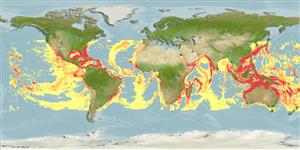Classification / Names
Common names from other countries
Main reference
Size / Weight / Age
Max length : 350 cm TL male/unsexed; (Ref. 9997); common length : 250 cm TL male/unsexed; (Ref. 9997); max. published weight: 346.0 kg (Ref. 40637); max. reported age: 25 years (Ref. 31395)
Length at first maturity
Lm 228.0, range 202 - 260 cm
Environment
Marine; reef-associated; oceanodromous (Ref. 51243); depth range 0 - 4000 m (Ref. 55180), usually 0 - 500 m (Ref. 6871)
Climate / Range
Subtropical; 23°C - 24°C (Ref. 244), preferred 27°C (Ref. 107945); 42°N - 43°S, 169°W - 180°E (Ref. 55180)
Distribution
Circumtropical. Western Atlantic: Massachusetts, USA to southern Brazil, including the Gulf of Mexico and the Caribbean Sea to Uruguay (Ref. 58839). Eastern Atlantic: Spain, Madeira to northern Angola; St. Paul's Rocks (Ref. 13121); Cape Verde (Ref. 34514). Indo-Pacific: scattered records from the Red Sea and Natal, South Africa (Ref. 5578) to China, New Zealand, and the Caroline, Hawaiian, Phoenix and Line islands. Eastern Pacific: southern Baja California, Mexico to northern Chile. Highly migratory species, Annex I of the 1982 Convention on the Law of the Sea (Ref. 26139).
Countries | FAO areas | Ecosystems | Occurrences | Introductions
Short description
Dorsal
spines
(total): 0;
Dorsal
soft rays
(total): 0;
Anal
spines: 0;
Anal
soft rays: 0. A large, slim shark with a moderately long, flat and rounded snout, large eyes, small jaws, and oblique-cusped teeth with serrations; 2nd dorsal fin low and with greatly elongated rear tip (Ref. 5578). Grey or bluish-grey above, white below; no conspicuous fin markings (Ref. 5578). Only Carcharhinus species with an interdorsal ridge that has the dorsal fin origin behind the free rear tip of the pectoral fin (Ref. 26938).
IUCN Red List Status (Ref. 115185)
Threat to humans
Traumatogenic (Ref. 9997)
Human uses
Fisheries: highly commercial
More information
ReferencesAquacultureAquaculture profileStrainsGeneticsAllele frequenciesHeritabilityDiseasesProcessingMass conversion
Tools
Special reports
Download XML
Internet sources
Estimates of some properties based on models
Phylogenetic diversity index
PD50 = 0.5000 many relatives (e.g. carps) 0.5 - 2.0 few relatives (e.g. lungfishes)
Trophic Level
4.5 ±0.0 se; Based on diet studies.
Resilience
Very Low, minimum population doubling time more than 14 years (rm=0.054; K=0.05-0.15; tm=6-10; tmax=25; Fec=2-14)
Vulnerability
Very high vulnerability (79 of 100)
Price category
